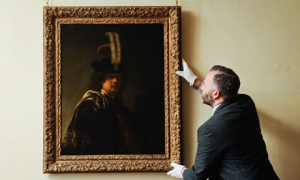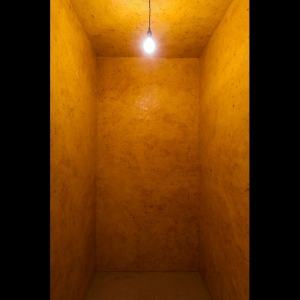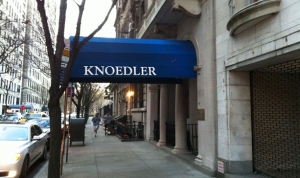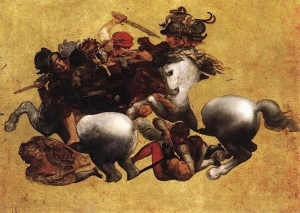|
Displaying items by tag: art collector

The Los Angeles Museum of Contemporary Art (MOCA) is ramping up endowment efforts after a wave of financial and administrative troubles left the institution’s future murky. Museum officials announced on Tuesday, March 26, 2013 that the amount of promised donations would raise MOCA’s endowment to $60 million, the highest in the institution’s 34-year history.
Jeffrey Soros, the president of MOCA’s board, and trustee Eugenio Lopez, a prominent art collector, are helming the new fundraising campaign known as MOCA Independence. The goal of the campaign is to raise $100 million, which will allow the museum to continue operating as an independent institution devoted to contemporary art.
MOCA’s troubles began in 2008 when overspending and dwindling investments left the museum with an endowment of a few million dollars. Eli Broad, a billionaire art collector and one of MOCA’s founding board members, gave the museum a second chance when he donated $15 million to the institution; Broad also pledged $15 million to match outsider contributions. While Broad’s generosity helped keep the museum afloat, MOCA struggled to find donors that would match his pledge.
MOCA’s troubles prompted partnership offers from the Los Angeles County Museum of Art and the National Gallery of Art in Washington, D.C. The museum declined both offers in favor of maintaining its independence.

In 2010, the UK’s National Trust was given five paintings from the estate of the late Edna, Lady Samuel of Wych Cross, the widow of Harold, Lord Samuel of Wych Cross, a property developer, philanthropist, and prominent art collector. Among the bequest was a portrait of an ornately dressed man believed to be a relatively unremarkable 17th century painting. Although the work bears a signature and date reading “Rembrandt 1635,” experts believed it to be a later copy or the work of one of the Dutch master’s pupils.
The painting, which spent nearly two years in storage, has just been identified as an authentic Rembrandt (1606-1669) self-portrait worth over $30 million. The painting hadn’t been examined since 1968 and recent X-ray analysis along with newly found circumstantial evidence from the Rembrandt Research Project indicates that the work is in fact genuine.
The self-portrait is the only Rembrandt in the National Trust’s collection of 13,500 paintings and will remain on view at Buckland Abbey through the end of tourist season. Once it is taken off view the painting will be undergo a thorough cleaning and further technical analysis. Experts will perform dendrochronology to date the beech panel the work is painted on, the paint will be analyzed, and the painting will be x-rayed again to check for under-drawings.
David Taylor, the National Trust’s curator of paintings and sculpture, expects to have a final confirmation on the painting by early next year.

The Phillips Collection in Washington, D.C. will unveil its first permanent installation in over 50 years. Founded by the art collector and critic Duncan Phillips (1886-1966) in 1921, the Phillips Collection is the United States’ first modern art museum.
The new addition to the institution is a room made entirely from beeswax titled Wax Room. The experimental piece is the work of Wolfgang Laib (b. 1950), a conceptual German artist who is well known for his sculptural works made from natural materials. Laib has been making his beeswax chambers for over 25 years using hundreds of pounds of melted beeswax to coat walls and ceilings. The otherworldly spaces he creates are warmly lit by single hanging light bulbs.
The Phillips Collection’s other permanent installation is its Rothko Room, which holds four paintings by the abstract expressionist painter Mark Rothko (1903-1970). The intimate presentation of Rothko’s works was added as a permanent exhibit in 1960, six years before Duncan Phillips’ death. Phillips worked closely with Rothko, deciding which walls to hang each painting on and the kind of lighting and furniture that would best suit the room. The Phillips Collection was the first American museum to dedicate a space to Rothko’s work and it remains the only one designed in collaboration with the artist himself.
Laib’s progressive work is a welcomed addition to the Phillips Collection. While Phillips’ holdings consisted of many Impressionist paintings and other mainstream works, he also had a taste for the unconventional. Phillips was one of the earliest patrons of American modernists including John Marin (1870-1953) and Arthur Dove (1880-1946) and also harbored great admiration for Abstract Expressionism before it became a respected art movement.
Laib’s Wax Room will be unveiled on March 2, 2013.

Prominent Canadian art collector David Mirvish filed a lawsuit on Friday, February 22, 2013 against the disgraced New York-based art gallery, Knoedler & Company. Since closing its doors in late 2011, Knoedler & Company has been accused by multiple clients of selling forged paintings, which were acquired by the gallery from Long Island dealer Glafira Rosales. Mirvish’s is the fifth lawsuit against Knoedler since 2011.
However, Mirvish’s claim is slightly different than its predecessors. While the other lawsuits accused Knoedler of passing off fake Jackson Pollock (1912-1956), Robert Motherwell (1915-1991), and Mark Rothko (1903-1970) paintings as the real deal, Mirvish claims that the works he purchased from the gallery were authentic. Instead, Mirvish is arguing that he lost out on millions of dollars in profits when Knoedler failed to sell three Jackson Pollock masterpieces he purchased jointly with the gallery.
Between 2002 and 2007 Mirvish purchased two paintings attributed to Pollock and bough a half stake in a third for $1.6 million. The sole purpose of Mirvish’s dealings with Knoedler was to resell the works for a profit. One of the Pollock paintings sold to collector and hedge fund manager Pierre Lagrange for $17 million in 2007, but in 2011, the day before Knoedler shut down, Lagrange announced that he would be filing a lawsuit against the gallery as forensic testing suggested the painting was a fake. The Lagrange suit was eventually settled but Mirvish was not involved and refused to return the money he made off of the deal.
Mirvish is now seeking reparations for the two unsold Pollocks, claiming that Knoedler breached its agreement when the gallery suddenly went out of business. Mirvish is asking Knoedler to return the two paintings, referred to as “Greenish Pollock” and “Square Pollock,” as well as reimburse him for his $1.6 million stake in the third painting, referred to as “Silver Pollock.” Even though Mirvish only paid Knoedler $3.25 million, half of “Greenish Pollock” and “Square Pollock’s” purchase prices, he claims that Knoedler’s violation of contract entitles him to both paintings.
Nicholas Gravante, the lawyer of Knoedler’s former president, Ann Freeman, is representing Mirvish. Freeman is not named as a defendant in Mirvish’s case and she has maintained that all works acquired from Rosales are genuine. Rosales is currently under investigation by the F.B.I.

When Henry Kravis, the co-chairman of the global investment firm KKR & Co., and prominent art collector Donald L. Bryant Jr. purchased a triptych by Jasper Johns (b. 1930) in 2008, the duo agreed to take turns exhibiting the works in their homes before eventually donating them to the Museum of Modern Art in New York. In a lawsuit recently filed by Kravis and his wife, Marie-Josée, the couple claims that Bryant violated their agreement when he refused to hand the works over to them on January 14, 2013. The Kravises stated that Bryant is essentially holding the works hostage until their agreement is amended, nixing the pledge to donate the paintings.
Considered one of the most important living American artists, Johns completed the three works titled Tantric Detail I, Tantric Detail II, and Tantric Detail III in 1980 and 1981. A powerful presence in the contemporary art market, Johns’ triptych is said to be worth between $15 million and $25 million. MoMA announced the Johns acquisition in a 2008 press release saying that the works were a “promised gift” from Bryant, who was one of the museum’s trustees at the time, Marie-Josée, the president of MoMA’s board of trustees, and her husband, Henry.
In their lawsuit, the Kravises ask that Bryant relinquish the works to them so that they can fulfill their vow to donate the paintings to MoMA.

On January 23, 2013, a three-judge federal appellate court in California heard arguments from the heirs and relatives of a prominent Hungarian art collector. The lead plaintiff, David de Csepel, is the great-grandson of Jewish banker Baron Mór Lipót Herzog whose legendary art collection once included works by El Greco (1541-1614), Anthony van Dyck (1599-1641), Diego Velázquez (1599-1660), Pierre-Auguste Renoir (1841-1919), and Claude Monet (1840-1926).
The case, which could be the last major art restitution case relating to the Holocaust, involves 40 artworks valued at $100 million that were seized by Nazis during World War II. Csepel argued that Hungarian courts acted unjustly as they have never returned the stolen paintings nor paid restitution to Herzog’s relatives. In fact, a number of paintings once belonging to Herzog remain in the collections of Hungarian museums.
The lawsuit is attempting to use U.S. courts to press charges against the Hungarian government, three of the country’s museums, and a university. However, the Hungarian government’s lawyers argue that U.S. courts have no jurisdiction on foreign soil, pushing to have the case played out in Hungarian courts or the International Court of Justice. The plantiff’s attorney, Michael Shuster, claims that the case is relevant for U.S. courts because most of the living heirs involved in the case are U.S. citizens and that Hungarian courts can be problematic.

Renowned art collector, Daphne Farago, announced that she will donate 161 works from her stunning collection to the Museum of Fine Arts, Boston. A longtime supporter of the MFA, Farago’s contribution is the largest gift of contemporary craft the museum has ever received and will greatly improve a once-lacking part of the collection.
Farago’s gift features works from the 20th and 21st centuries by artists such as Dale Chihuly (b. 1941), Sam Maloof (1916-2009), and John Cederquist (b. 1946). The pieces range from works of fiber, ceramics, glass, woodcarvings, and metal to furniture, jewelry, basketry, and folk art. The newly acquired works, man of which have remained out of public view until now, will be exhibited in the museum’s Farago Gallery beginning in August 2013.
This is the third major donation from Farago and her late husband, Peter to the MFA; their contributions total $2.5 million to $5 million in art and money, which prompted the museum to open the Farago Gallery in September 2011 as part of the Linde Family Wing for Contemporary Art. Edward Saywell, Chair of the Linde Family Wing, said, “Although the MFA has a distinguished history of collecting and exhibiting contemporary craft, this gift broadens and deepens our holdings in truly significant ways. The gift will be a touchstone for the collection and will be a remarkable legacy.”

Between 1938 and his death in 1956, G. David Thompson, a steel tycoon and passionate art collector made a number of sizable donations to his alma mater, Peru High School in Indiana. Thompson’s generous gifts were in honor of his art teacher, John Whittenberger, who inspired the former troublemaker to change and his ways and helped set him on the path that led to his eventual success.
Thompson graduated from Peru High School in 1913 and established his own investment banking company in Pittsburgh during the Great Depression. By 1945, he was at the helm of four steel companies in the city. With ample funds, Thompson became a fervent art collector, often buying works by unknown artists who went on to become quite established. His multi-million dollar collection included works by Paul Klee (1879-1940), Georges Braque (1882-1963), Claude Monet (1840-1926), Henri Matisse (1869-1954), Jackson Pollack (1912-1956), Piet Mondrian (1872-1944), Paul Cézanne (1839-1906), Vincent van Gogh (1853-1890), Alberto Giacometti (1901-1966), and Edgar Degas (1834-1917).
While Thompson made a number of donations to major museums, he ultimately gifted 75 paintings and prints, one sculpture, and 54 pieces of oriental pottery to Peru High School. The exhibition Hidden Treasures: The John Whittenberger Collection of G. David Thompson at Peru High School at the Fort Wayne Museum of Art features a portion of the dozens of works Thompson sent to Whittenberger. Works on view include pieces by William Merritt Chase (1849-1916), Salvador Dalí (1904-1989), and Pablo Picasso (1881-1973). Hidden Treasures is on view through February 24, 2013.

British art collector, Douglas A.J. Latchford, has spent decades building his reputation as one of the foremost experts in Khmer antiquities. Latchford, a resident of Thailand, was knighted in 2008 by the Cambodian government for admirably returning 14th-century Khmer artifacts.
In sharp contrast to his previous accolades, Latchford is currently the subject of a civil complaint files by the U.S. attorney’s office. Federal lawyers state that Latchford, referred to in proceedings as “the Collector,” bought a 10th century Khmer warrior statue known as the Duryodhana in the 1970s knowing that it had been looted from a temple during the Cambodian civil war.
While Latchford denies ever having owned the work, court papers claim that he purchased the statue from a Thai dealer who acquired the work from an organized looting network. Allegedly, Latchford then helped get the piece into Britain by concealing what was actually being shipped. Upon its arrival to the U.K., the auction house Spink & Son sold the statue to a Belgian collector in 1975. The collector’s widow is the Duryodhana’s current owner.
The widow approached Sotheby’s New York in 2010, hoping to sell the 500-pound sandstone statue. However, the sale was put on hold because of objections from the Cambodian government. While lawyers are hoping to return the work to Cambodia, the auction house still plans on selling the treasure, stating that there is no evidence to prove that the statue was looted or that it is the property of the Cambodian government.
Latchford has been collecting Cambodian antiquities for over 55 years and has donated many works to well-known institutions, including the National Museum in Phnom Penh and the Metropolitan Museum of Art. A judge is expected to rule on the Duryodhana case within the next few months.

A division of the Italian police department that specializes in art thefts has located a 400-year-old copy of a lost Leonardo da Vinci fresco. Depicting the Battle of Anghiari, the masterpiece was never finished.
The copy, widely known as the Tavola Doria, once adorned a wall of Florence’s city hall, the Palazzo Vecchio, and illustrates a historic battle between Florence and Milan that took place in 1440. It is believed that da Vinci experimented with various fresco-painting techniques before he started work on the battle scene in 1503. Despite his efforts, the paints began to drip and da Vinci was never able to finish the fresco. Over the next few years, the piece deteriorated and the Italian painter, Giorgio Vasari, was commissioned to paint over what was left of the incomplete fresco.
Since the unfinished da Vinci painting no longer exists, copies of the lost artwork are extremely important to art historians and scholars. This particular copy, painted on a small wooden panel, was last seen in public 73 years ago at a Leonardo da Vinci exhibition held in Milan on the eve of World War II. After the exhibition, the work disappeared.
Experts have since determined that the panel was stolen from its owners in Naples and ended up in the hands of a Swiss art dealer. The work was sent to Germany for restoration in the 1960s, made a brief appearance in the 1970s at an art gallery in New York, and by the 1990s was the property of a wealthy Japanese art collector.
Finally back in Italy, the Tavola Doria will be on view at Florence’s Uffizi Gallery during 2013. The work will then spend four years in Japan as part of a loan agreement worked out with the Fuji Art Museum in Tokyo, where it was last exhibited.
|
|
|
|
|